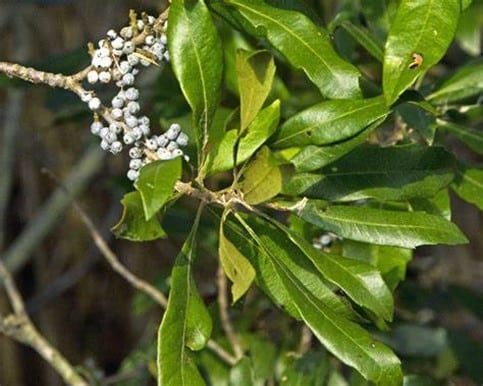Photo by University of Florida, IFAS
Our southern wax myrtle (Myrica cerifera), also called bayberry and candle berry is a relatively quick growing, small, evergreen native shrub or tree, capable of reaching a height of about 25 feet and can grow an equal horizontal spread. These small trees often have multiple, twisted trunks with smooth, light grey bark and aromatic, olive green leaves.
Small white flowers bloom in the spring. During the winter season, the female plants produce clusters of grey-blue, waxy berries, which are appealing and important to wildlife.
Southern wax myrtle is tolerant of a variety of landscape conditions from partial shade to full sun. They grow well in the range of low, wet mucky soils to high well-drained sandy soils. The plants grow relatively thin in total shade. But they are also very salt-tolerant, making it suitable for coastal dunes and seaside yards. They are cold hardy and can easily take our occasional winter frost in North Florida. They are commonly used as a hedge or privacy screen for yards. They can be shaped and respond well to proper pruning. A creative landscape manager can prune the crown into a multi-stemmed dome-shaped topiary. Wax myrtles are generally healthy, free of insect pests and diseases that can inflict other small trees and shrubs.
In our region, this hardy Florida native has waxy berries that are an important winter food source of many local birds – quail, turkey, several species of ducks and wading birds, brown thrasher, bluebird, and many warblers. The shrub or tree form also provides nesting shelter and perching for birds and concealment for wildlife, such as small rodents and rabbits. Even the leaves are a larval food source of the red-banded hairstreak butterfly.
Wax myrtle can be an opportunistic coppicing (sprouting) plant. They can form dense thickets in abandoned pastures and agricultural areas leading to ecological succession. In a natural system, landscape fires will control such thickets. The oil in the plant’s leaves causes them to ignite quickly in a fire. Though a highly flammable plant, the root crown will regenerate after a fire.
Renowned naturalist William Bartram, while exploring the Southeastern colonies and territories from 1773 to 1777 identified the wax myrtle. Resourceful Native Americans discovered and made aromatic bayberry candles from the berries. Later this process was introduced to early colonists and settlers. The berries, when boiled in water would make a wax that burns with a scented blue flame. The leaf foliage is also aromatic and flavorful. Some chefs use the notched leaves, whole or crushed, to flavor meals. The plant’s aromatic leaves once thought to repel fleas and other pesky insects were used in dog kennels. Wax myrtle in bush or small tree forms are also excellent hardy native landscape plant.
Mike Adams, a member of the Bartram Trial Society of Florida, is an ecologist, educator, researcher and author. He has lived in worked along the St. Johns River since 1980.
Email: adamscience@windstream.net
